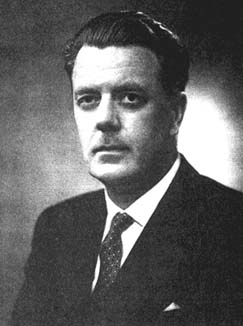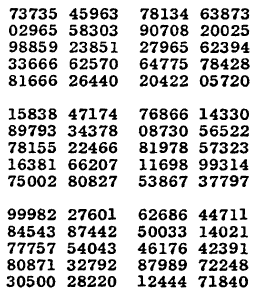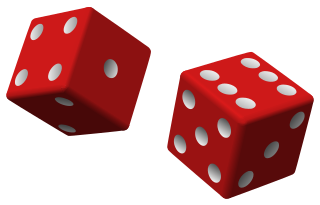A pseudorandom sequence of numbers is one that appears to be statistically random, despite having been produced by a completely deterministic and repeatable process. Simply put, the problem is that many of the sources of randomness available to humans rely on physical processes not readily available to computer programs.

Benford's law, also known as the Newcomb–Benford law, the law of anomalous numbers, or the first-digit law, is an observation that in many real-life sets of numerical data, the leading digit is likely to be small. In sets that obey the law, the number 1 appears as the leading significant digit about 30% of the time, while 9 appears as the leading significant digit less than 5% of the time. If the digits were distributed uniformly, they would each occur about 11.1% of the time. Benford's law also makes predictions about the distribution of second digits, third digits, digit combinations, and so on.
A pseudorandom number generator (PRNG), also known as a deterministic random bit generator (DRBG), is an algorithm for generating a sequence of numbers whose properties approximate the properties of sequences of random numbers. The PRNG-generated sequence is not truly random, because it is completely determined by an initial value, called the PRNG's seed. Although sequences that are closer to truly random can be generated using hardware random number generators, pseudorandom number generators are important in practice for their speed in number generation and their reproducibility.

A linear congruential generator (LCG) is an algorithm that yields a sequence of pseudo-randomized numbers calculated with a discontinuous piecewise linear equation. The method represents one of the oldest and best-known pseudorandom number generator algorithms. The theory behind them is relatively easy to understand, and they are easily implemented and fast, especially on computer hardware which can provide modular arithmetic by storage-bit truncation.
The Mersenne Twister is a general-purpose pseudorandom number generator (PRNG) developed in 1997 by Makoto Matsumoto and Takuji Nishimura. Its name derives from the fact that its period length is chosen to be a Mersenne prime.

In computing, a hardware random number generator (HRNG), true random number generator (TRNG), non-deterministic random bit generator (NRBG), or physical random number generator is a device that generates random numbers from a physical process capable of producing entropy, unlike the pseudorandom number generator that utilizes a deterministic algorithm and non-physical nondeterministic random bit generators that do not include hardware dedicated to generation of entropy.

Sir Maurice George Kendall, FBA was a prominent British statistician. The Kendall tau rank correlation is named after him.
The security of cryptographic systems depends on some secret data that is known to authorized persons but unknown and unpredictable to others. To achieve this unpredictability, some randomization is typically employed. Modern cryptographic protocols often require frequent generation of random quantities. Cryptographic attacks that subvert or exploit weaknesses in this process are known as random number generator attacks.
A random password generator is a software program or hardware device that takes input from a random or pseudo-random number generator and automatically generates a password. Random passwords can be generated manually, using simple sources of randomness such as dice or coins, or they can be generated using a computer.

A Million Random Digits with 100,000 Normal Deviates is a random number book by the RAND Corporation, originally published in 1955. The book, consisting primarily of a random number table, was an important 20th century work in the field of statistics and random numbers.
A numeric sequence is said to be statistically random when it contains no recognizable patterns or regularities; sequences such as the results of an ideal dice roll or the digits of π exhibit statistical randomness.
Randomness has many uses in science, art, statistics, cryptography, gaming, gambling, and other fields. For example, random assignment in randomized controlled trials helps scientists to test hypotheses, and random numbers or pseudorandom numbers help video games such as video poker.

Random number generation is a process by which, often by means of a random number generator (RNG), a sequence of numbers or symbols that cannot be reasonably predicted better than by random chance is generated. This means that the particular outcome sequence will contain some patterns detectable in hindsight but impossible to foresee. True random number generators can be hardware random-number generators (HRNGs), wherein each generation is a function of the current value of a physical environment's attribute that is constantly changing in a manner that is practically impossible to model. This would be in contrast to so-called "random number generations" done by pseudorandom number generators (PRNGs), which generate numbers that only look random but are in fact pre-determined—these generations can be reproduced simply by knowing the state of the PRNG.
CryptGenRandom is a deprecated cryptographically secure pseudorandom number generator function that is included in Microsoft CryptoAPI. In Win32 programs, Microsoft recommends its use anywhere random number generation is needed. A 2007 paper from Hebrew University suggested security problems in the Windows 2000 implementation of CryptGenRandom. Microsoft later acknowledged that the same problems exist in Windows XP, but not in Vista. Microsoft released a fix for the bug with Windows XP Service Pack 3 in mid-2008.

The ziggurat algorithm is an algorithm for pseudo-random number sampling. Belonging to the class of rejection sampling algorithms, it relies on an underlying source of uniformly-distributed random numbers, typically from a pseudo-random number generator, as well as precomputed tables. The algorithm is used to generate values from a monotonically decreasing probability distribution. It can also be applied to symmetric unimodal distributions, such as the normal distribution, by choosing a value from one half of the distribution and then randomly choosing which half the value is considered to have been drawn from. It was developed by George Marsaglia and others in the 1960s.

In common usage, randomness is the apparent or actual lack of definite pattern or predictability in information. A random sequence of events, symbols or steps often has no order and does not follow an intelligible pattern or combination. Individual random events are, by definition, unpredictable, but if the probability distribution is known, the frequency of different outcomes over repeated events is predictable. For example, when throwing two dice, the outcome of any particular roll is unpredictable, but a sum of 7 will tend to occur twice as often as 4. In this view, randomness is not haphazardness; it is a measure of uncertainty of an outcome. Randomness applies to concepts of chance, probability, and information entropy.
A standard normal deviate is a normally distributed deviate. It is a realization of a standard normal random variable, defined as a random variable with expected value 0 and variance 1. Where collections of such random variables are used, there is often an associated assumption that members of such collections are statistically independent.

A random number book is a book whose main content is a large number of random numbers or random digits. Such books were used in early cryptography and experimental design, and were published by the Rand Corporation and others. The Rand corporation book A Million Random Digits with 100,000 Normal Deviates was first published in 1955 and was reissued in 2001. A sequel, A Million And One Random Digits was published in 2022.
Bernard Babington Smith, OBE (1905-1993) was a British academic, wartime intelligence officer and amateur athlete.







